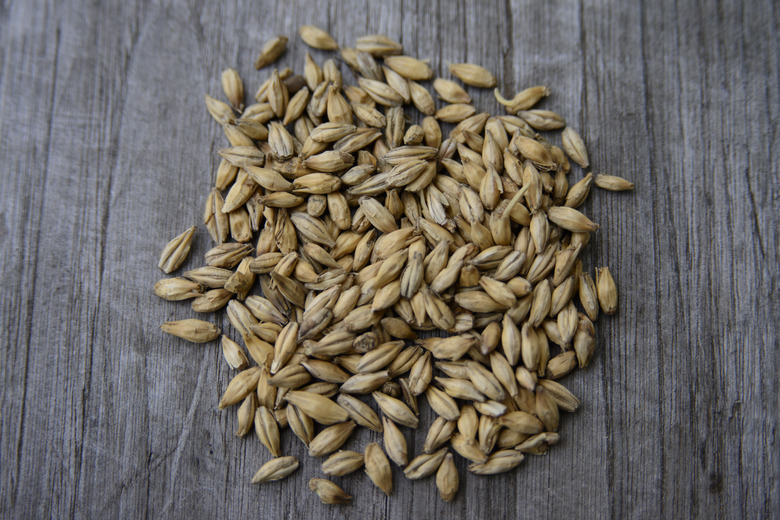Plants That Contain Amylase
Amylases are enzymes that are naturally occurring in many organisms, including animals and plants. There are several forms of amylase, with alpha-, beta- and gamma-amylases being the three primary classes. Alpha-amylases are prominent in animals and people, while beta-amylases are prominent in plants.
TL;DR (Too Long; Didn't Read)
Amylases are protein enzymes that are used in the digestion of starches into simple sugars. There are three main types: [alpha-, beta- and gamma-amylases](https://www.ncbi.nlm.nih.gov/books/NBK557738/), and they each work on breaking down different parts of carbohydrates. Foods rich in amylase include potatoes, sweet potatoes, soybeans and cereal grains.
What Are Amylases?
What Are Amylases?
Amylases are digestive enzymes. They are one of the first enzymes to have been thoroughly researched, and were first described in the nineteenth century.
The purpose of an amylase enzyme is to break down starches, or polysaccharides, into simple sugars, or monosaccharides. There are three main types: alpha-, beta- and gamma-amylases, and they each work on breaking down different parts of carbohydrates.
The sources of amylases by type include alpha-amylase in microbes, animals and plants. Beta-amylase is prevalent in microbes and plants. Gamma-amylase sources include plants and animals.
Alpha-Amylase
Alpha-Amylase
Since the early 1900s, alpha-amylase has been used as a laboratory test marker. Alpha-amylase can be found in the pancreas or in saliva. In urine or blood tests, elevated amylase levels indicate potential disease markers. The opposite scenario, reduced amylase levels, can be found in other conditions.
Diseases that cause elevated alpha-amylase include pancreatitis, intestinal diseases, gallbladder disease, some malignancies and gynecological disorders. On the other hand, liver disease, preeclampsia, kidney disease and cystic fibrosis can reduce amylase levels. Isoforms of alpha-amylase include salivary amylase (S-amylase) and pancreatic amylase (P-amylase).
Within saliva and the pancreas, digestion of carbohydrates occurs. This is why deviations from normal levels of amylase indicate there could be problems. About 5% of initial digestion occurs via salivary amylase before food even arrives at the stomach. Other sources of amylase production include the ovaries, fallopian tubes, the liver and the small intestine.
A number of plants can work as inhibitors of alpha-amylase, and these are under research as potentially beneficial treatments for hyperglycemia and diabetes mellitus. These amylase-inhibiting plants include Syzygium cumini L., Psidium guajava L., Amaranthus caudatus L., Rhodiola rosea L., and many other potential plant candidates.
Beta-Amylase
Beta-Amylase
In contrast to alpha-amylase, beta-amylase plays a much larger role in plants. Beta-amylases are important for brewing and distilling, as they are part of the malting process. A number of beta-amylases are responsible for the degradation of plastid starch. Many studies about beta-amylase have been performed using the flowering plant Arabidopsis thaliana.
Scientists have found that beta-amylases formed about 400 million years ago and have diversified over time along with plants and other organisms. Beta-amylases are not found in animals or fungi. In green algae, present beta-amylase enzymes do not closely resemble much later species such as cereal plants. Researchers think that beta-amylases diverged once land plants developed.
Plants That Contain Amylases
Plants That Contain Amylases
Since plants are used as food for many organisms, including people, there are amylases in food. Plant foods rich in amylase include soybeans, sweet potatoes, barley, potatoes, rice, tomatoes and cereal grains.
Because many of the foods rich in amylase are valuable crop plants, amylases have been studied in those plants. Researchers still attempt to elucidate the functions of beta-amylases. Evidence suggests the enzymes play a crucial role in leaf starch turnover in some of these plants. If the genes for beta-amylases are overexpressed, it leads to stunted plants and other problems.
Sources of beta-amylases in food include grains essential to brewing. Beta-amylase affects the malting quality of brewing grains. The malting process requires beta-amylose to produce maltose in the mashing phase, which in turn affects the amount of alcohol yeast can produce. Scientists face challenges studying these grains because their genetic makeup is redundant and complex, with polyploidy of their genomes being a common feature. Researchers will continue to learn more about how beta-amylase in food works.
Cite This Article
MLA
Hermance, Dianne. "Plants That Contain Amylase" sciencing.com, https://www.sciencing.com/plants-that-contain-amylase-13428064/. 20 October 2021.
APA
Hermance, Dianne. (2021, October 20). Plants That Contain Amylase. sciencing.com. Retrieved from https://www.sciencing.com/plants-that-contain-amylase-13428064/
Chicago
Hermance, Dianne. Plants That Contain Amylase last modified March 24, 2022. https://www.sciencing.com/plants-that-contain-amylase-13428064/
